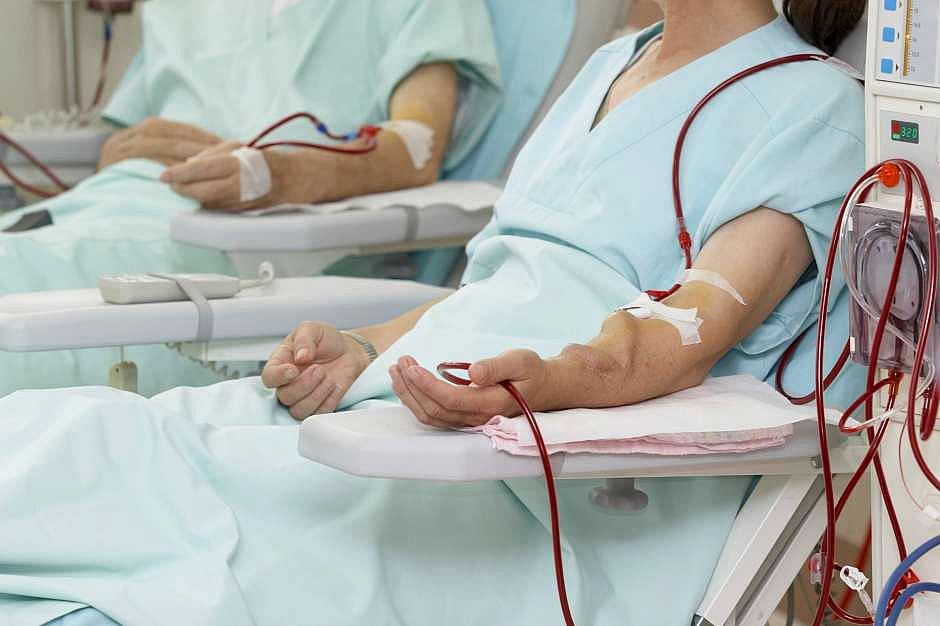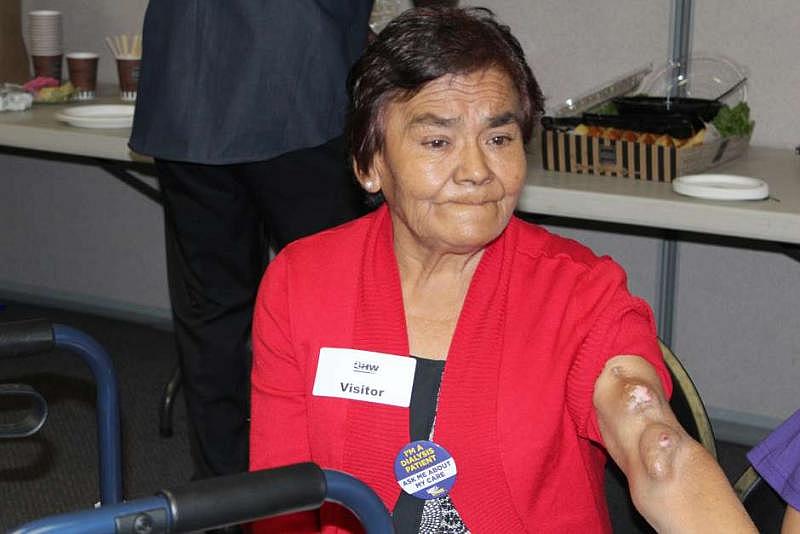Diabetes to dialysis, a life-threatening progression
Francisco Castro’s reporting on diabetes was undertaken as a USC Center for Health Journalism California Fellow.
Other stories in the series include:
'I feel like a prisoner' says man who lost his sight due to diabetes
Diabetes robs Latinos of prosperous lives
REPORTAJE: ¿Cómo la ‘teleterapia’ ha ayudado a víctimas de la violencia doméstica?
REPORTAJE: Violencia doméstica se agudiza en la pandemia entre mujeres inmigrantes
REPORTAJE: VAWA y Visa-U: alivios migratorios para sobrevivientes de violencia doméstica

People receive treatment at a dialysis center. (Shutterstock)
[Click HERE for the Spanish version.]
Susana Castro’s arms are deformed, bruised and mangled, with furrows and huge swelling. It is the result of the dialysis treatment she needs every third day because her kidneys have not been working properly for 11 years.
Renal failure comes from the diabetes that this grandmother has suffered for 28 years, which in recent years has been accompanied by dementia.
“She cannot be alone,” says Cristina Castro Paz, her daughter, who takes care of her at all times, including laborious trips to the dialysis center.
In fact, two years ago during one of these dialysis sessions (that last three hours), the nurse who was in charge did not check Castro’s sugar level for two hours. The 68-year-old woman ended up in the emergency room.
Susana Castro’s arms show the damages caused by her dependence on dialysis after her diabetes led to kidney failure. (Francisco Castro)
“She was in diabetic coma” for several days, her daughter recalled. “We didn’t know if she was going to wake up or not.”
She says that her mother was diagnosed with diabetes in her native Mexico City where she worked selling food on the streets. Being illiterate, with mouths to feed and without financial resources, Castro did not take care of her illness.
“She didn’t take the medicines,” Castro’s daughter explained.
First came the high pressure, which combined with diabetes began to undermine her renal function.
A common evil
It is a common progression for diabetics, who represent 44% of all new patients with renal problems, according to the American Diabetes Association.
But it is also a problem that greatly affects Latinos. The National Kidney Foundation reports that 14.7% of all new renal failure cases in 2013 were in Hispanic patients. In fact, Latinos are 1.5 times more likely to develop kidney problems than other ethnicities.
Dr. Joseph Wanski, an endocrinologist with L.A. Care, says the kidney problems develop when nephrons, blood-filtering structures that help eliminate body waste and control fluid balance, become hard and thick.
“This generates leaks” and they let protein pass into the urine.
“Controlling diabetes prevents progression to the kidneys,” he explains.
So far that has prevented Maria Gomez from joining the growing ranks of dialysis patients.
The 57- year-old Guatemalan has had diabetes for 20 years.
Maria Gomez has already been warned by her doctor that she will probably need dialysis treatment in the near future. (Francisco Castro)
“I had gestational diabetes and it went off. Ten years later, it came back when I didn’t keep taking care of myself,” she says.
With the passage of time, “The retina in my eyes broke” and she lost sight in one of her eyes.
“I went to sleep and I could still see, and when I woke up I said to my son ‘is it still dark?’ And he said ‘no mom. There’s sunshine.”
She sees a little with her left eye, which helps her move around without help, but with the right she sees nothing.
Gomez needs insulin shots every night because her pancreas no longer works. Diabetes has also started to damage one of her kidneys, which only works at 45%. The other is not affected, for the moment.
“I was swelling because my body retains fluids,” she said of how her renal problems started.
The problem was that her diabetes was out of control. She’s managed to rebound, which has minimized the condition, but her doctor already told her that in the near future she will need dialysis.
We are all born with kidneys that function at 100% cleaning our bodies of impurities and wastes. When that efficiency falls to 10-15% and “the body cannot take out the toxins”, that’s when dialysis is needed, said Dr. Wanski.
“Dialysis patients who are sufficiently healthy are given the opportunity to have a kidney transplant from a relative, but those are often offered to young individuals who can withstand” the surgery, he said.
People can survive with one kidney.
Those who receive a transplant need to take powerful drugs to prevent the body from rejecting the new organ and need a strong support system, both medical and familial.
All of this costs between $200,000 and $300,000. Medicare can pay for it, but not everyone has access to in the Latino community because of immigration status.
A study published in 2008 by the American Medical Association revealed that illegal immigrants donate about 2.5% of all transplanted organs annually in the United States. However, they are recipients of less than 1% of all organ transplants.
Emergency Medicaid (in California Medi-Cal) is the only coverage accessible to the undocumented poor, and it does not pay for transplants. But it does pay for dialysis treatment.
That’s why thousands of Hispanic patients (about 63,000 in California) rely on dialysis centers for their survival.
Dialysis replaces some of the kidney’s functions and is necessary to remove toxins (impurities or wastes) from the blood when the kidneys are unable to do so. However, the procedure is slow and dangerous. Carelessness during treatment can lead to infections or other complications.
In 2014 alone, 13 patients died for each of the 562 dialysis clinics in the state, according to the International Union of Service Workers and its division of United Health Care Workers West (SEIU-UHW). One in eight of those deaths was due to infections, according to state health regulators.
An effort to tame the dialysis industry
The dialysis industry has grown powerful in this environment. It generates revenues of $2.9 billion annually in California alone and is dominated by the companies DaVita and Fresenius.
A proposal in the November ballot seeks to tame its influence.
The measure would limit the earnings of these companies to 15% above what they spend on patient care. If they pass that number, companies would have to reimburse the difference to insurers and patients. In addition, it requires more staff training, education, and patient counseling.
Last month, the International Union of Service Workers and its division of United Health Care Workers West (SEIU-UHW) presented 600,000 signatures in support of the measure, which have already been certified. That means voters will get to decide on the issue in the November 6 general election.
The California Chapter of the American College of Emergency Physicians (ACEP) opposes the idea, as well as the California Medical Association and the Association of Renal Physicians.
Though the measure does not seek to limit patient visits, ACEP argues that the proposal would lead to more emergency room visits from dialysis patients.
“As emergency physicians, we regularly treat dialysis patients who end up in the ER due to missed dialysis appointments or complications from kidney failure,” said Dr. Aimee Moulin, president of California ACEP. “Missing even one appointment can be fatal for dialysis patients”.
Exercise to fight diabetes
It’s Friday morning and about 25 women and one man – all of them seniors – are gathered in the City of San Fernando’s Recreation Park.
They stretch and then begin to move their feet, arms, and legs into a low-impact workout divided into three stages. Cheerful music blares from stereo speakers stationed around them.
This is the free 3 Wins Fitness program from California State University, Northridge (CSUN) that began in 2011 with 20 participants at one location and has now expanded to 16 different sites around the San Fernando Valley and hundreds of participants.
“As the country’s rates of obesity and related diseases such as diabetes and heart disease continue to rise along with high levels of inactivity, it becomes important to provide accessible programs…particularly in underserved communities,” said Steven Loy, professor of Kinesiology and program counselor.
Valen Sinisgali, the manager of the classes in the park and CSUN Kinesiology student, said the “If they (the participants) lose 5-7% of their body fat, they reduce their risk of developing diabetes by 50%”.
Exercise also helps prevent other age-related ills, such as osteoporosis. It improves balance, and reduces falls.
Ana Valadez, a 75-year-old native of El Salvador, doesn’t miss a single class.
She was diagnosed with diabetes more than 20 years after suffering from dizziness and incessant thirst.
Since then she’s tried to control her blood sugar levels.
“I know that with soda and fried plantain (the latter one of the typical dishes in her country) my sugar goes up,” she says. “I try to avoid it.”
She also takes a Zumba class.
“I check it (my sugar level) every day even if I don’t feel bad,” she says. She’s been able to keep herself free of all the other ills associated with diabetes.
Before starting these classes, she often complained of sore foot.
“With these exercises that I take, it no longer hurts,” said Valadez.
For information on the locations and times where these free classes are offered, visit http://www.3winsfitness.com/
[This story was originally published by La Opinion.]
